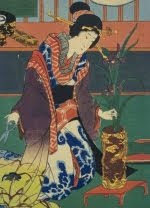In June this year I had my first teacher's exam for the Sogetsu School of ikebana. Yesterday I finally got the certificate issued by the present iemoto (headmaster) Akane Teshigahara. What can I say - it was worth waiting for.
As you can see my new teachers name is Senju. I don't really know what it means, so if any of you that know Japanese have thoughts on the interpretation of the name I would appreciate a comment. Thanks!














